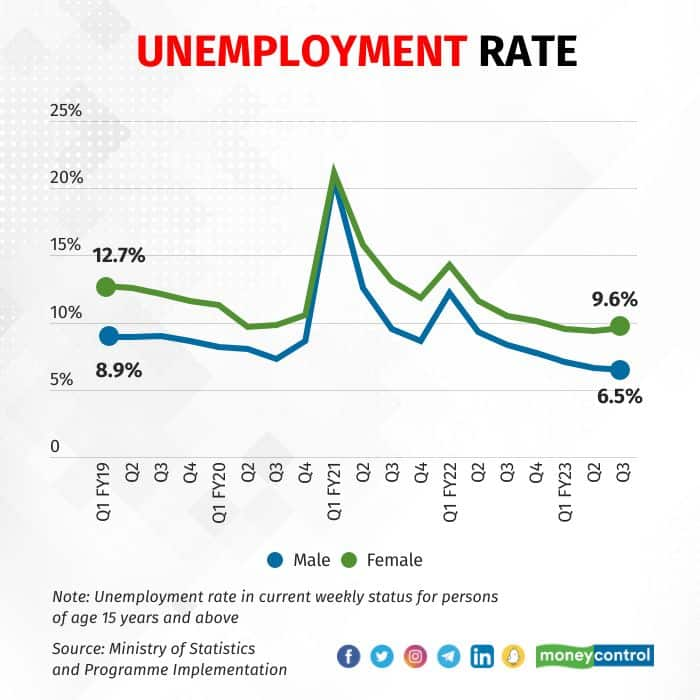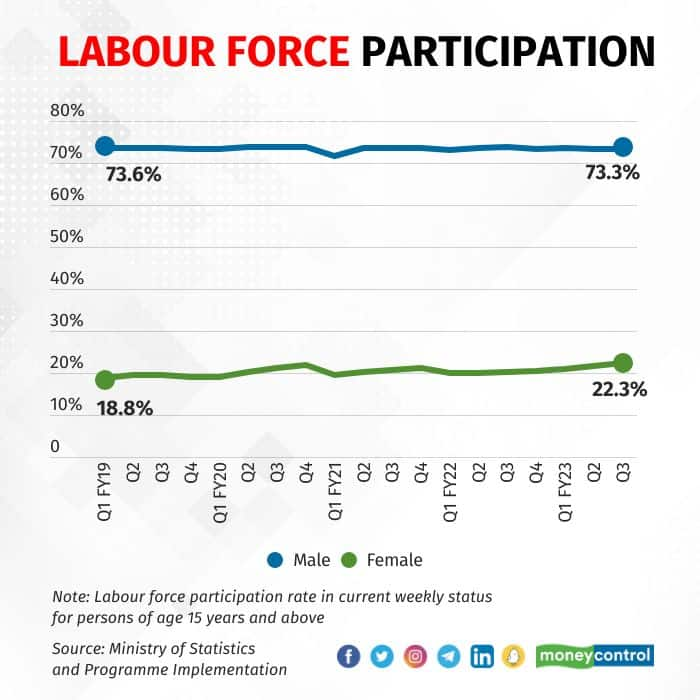Representative image
That the Indian job market is difficult to crack for women is nothing new. And neither is the fact that some gains are being made. But how rapid, or gradual, are these improvements?
Let us begin with unemployment.
According to the statistics ministry's Periodic Labour Force Survey, the unemployment rate for urban females aged 15 years and above, as measured by the current weekly status, had fallen to 9.6 percent in the last quarter of 2022 from a pandemic-period peak of 21.1 percent in April-June 2020.

Under the current weekly status definition, a person is considered unemployed in a week if she doesn't work even for an hour on any day despite being available for work at least for an hour on any day.
The employment status is determined on the basis of a reference period - the last seven days preceding the date of the survey.
The most recent female unemployment rate is even lower than the levels seen prior to the pandemic. In fact, the female unemployment rate during the current financial year is the lowest it has been stretching back to April-June 2018, when these surveys began.
Of course, it goes without saying that unemployment among males is lower – more than 300 basis points lower in October-December 2022, to be precise.
One basis point is one-hundredth of a percentage point.
However, if one considers rural India, the statistics ministry's annual labour force survey reports show the all-India female unemployment rate was a mere 3.3 percent in 2021-22 (July-June), well below 4.2 percent in 2019-20, and even the male all-India unemployment rate of 4.4 percent last year.
One cannot, of course, look at the unemployment rate in isolation. After all, this indicator does not take into account how many people are looking for jobs. This is where matters get a tad ugly.
In October-December 2022, the female labour force participation rate was a pitiful 22.3 percent, less than a third of the rate for males, which was 73.3 percent.

But the numbers show progress has been made. If one goes back to the first quarterly survey in April-June 2018, the male and female labour force participation rates were 73.6 percent and 18.8 percent, respectively.
According to the annual surveys, the all-India female labour force participation rate has risen from 23.3 percent in 2017-18 to 32.8 percent in 2021-22. In rural areas, the participation rate has shot up to 36.6 percent from 24.6 percent over the same period, while in urban areas, it has crawled up to 23.8 percent from 20.4 percent.
How does India compare with other countries when it comes to female labour force participation rate? Not well at all, with only countries such as Yemen, Iraq, Iran, Jordan, Algeria, Egypt, Syria, Niger, Afghanistan, Kosovo, Saudi Arabia, and Palestine having a lower female labour force participation rate than India, as per data from the International Labour Organization.
Clearly, India has a long way to go in making the job market equitable.